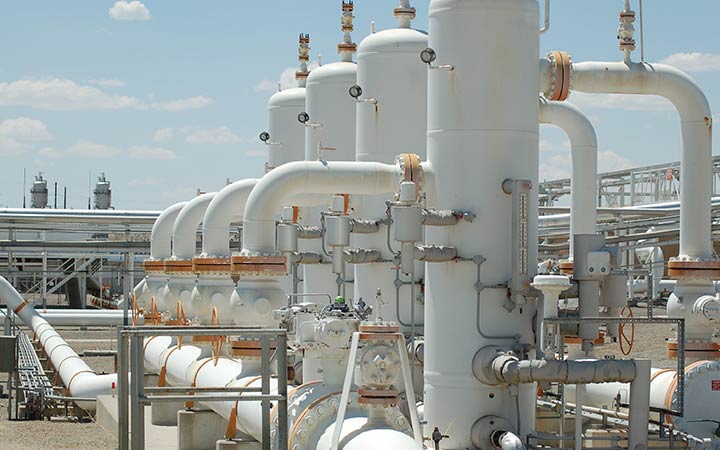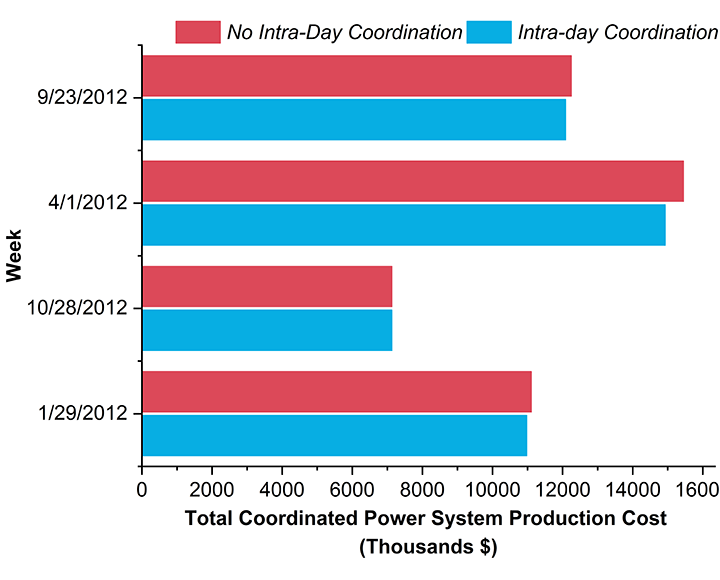Intra-Day Coordination of Natural Gas and Electricity Offers Cost and System Benefits

Photo courtesy of Kinder Morgan.
May 5, 2020—Over the past decade, declining natural gas prices and environmental regulations have increased the use of natural gas as a power source in the U.S. energy grid. In 2016, it surpassed coal-fired power generation.
With increasing renewables and policies to decarbonize the power sector, natural gas will likely continue to play a bigger role in the power system. This raises concern for how to coordinate the natural gas and electricity sectors to ensure reliable, affordable electricity supply.
JISEA analysts Bri-Mathias Hodge and Omar Guerra, along with partners in academia and energy software and supported by a diverse consortium of sponsoring organizations, completed one of the first studies on the value of intra-day natural gas-electricity coordination. Enhanced coordination proved to be low-hanging fruit.
"With minimal infrastructure, we can align the gears between the electric and natural gas sectors to operate as independent but coordinated systems. This will improve the strength and efficiency of our U.S. energy grid, not in 10 or 20 years, but in the next couple years," Bri-Mathias Hodge said.
Natural Gas Deliverability Constraints
Natural gas and electricity networks weren't built to work together; now that they're becoming increasingly inter-dependent, natural gas system constraints are becoming more obvious. For example, the 2014 polar vortex brought cold weather and peak electricity demand that strained all types of energy sources.
Generators experienced extended run times, but natural gas delivery constraints prohibited some types of power generation that resulted in many generators shutting down.
This event jumpstarted efforts to align natural gas and electric power system operations. In 2015, the U.S. Federal Energy Regulatory Commission issued Order No. 809, "Coordination of the Scheduling Processes of Interstate Natural Gas Pipelines and Public Utilities," to improve day-ahead and intraday coordination.
Many studies have taken place on day-ahead coordination, but little research exists on intra-day coordination, which motivated JISEA analysts to do this study.
How the Study Worked
To assess the value of intra-day coordination, JISEA analysts created a co-simulation platform to produce electricity in the most affordable way possible.
The model pulls hourly natural gas output offtakes and plugs it into a dynamic gas simulation model, which returns maximum fuel offtakes for gas-fired generators. Various constraints were then added to capture how gas network limitations impact gas-fired generators' operations. Read the article for the full methodology.
The analysts applied this modeling to a test case—a power system with 186 transmission lines connecting 118 electrical buses, wind and solar generators to represent the evolving power mix, and a 90-pipeline natural gas network with gas-fired generators and underground storage.
The analysts compared real-time power and gas system data with and without intra-day coordination for one week each season with the highest demand.
Intra-Day Coordination a Win-Win
Intra-day coordination proved to have big benefits, particularly on higher demand days.
The analysts found that intra-day coordination allows for more natural gas-fired generation. This reduces real-time redispatch for nearly all generators, meaning tey do not have to lower their power output. For one generator, it reduced real-time redispatch by 50%.
More gas-fired generation helps mitigate real-time power system production costs for starting up or increasing generation. For the week of September 23, it reduced production costs by 4%. Less expensive production can reduce customer rates. Plus, more gas-fired generation means more revenue for gas plants.

In every season except winter, intra-day coordination lowers power system production costs by 1%–4%.
Intra-day coordination is even more valuable with wind and solar penetration, which are expected to increase. By replacing gas-fired generation with less-expensive wind and solar, power system production costs drop further, and gas network constraints are alleviated.
The analysts emphasize that enhanced coordination—whether it's information exchange or aligning electricity and gas markets—doesn't require significant new infrastructure. This means that system operators and consumers could take advantage of these improvements soon.
This study was led by Bri-Mathias Hodge and Omar Guerra from the National Renewable Energy Laboratory, along with Michael Craig from the University of Michigan.
This study was sponsored by a consortium of organizations including Kinder Morgan, Midcontinent Independent System Operator, Hewlett Foundation, Environmental Defense Fund, American Gas Association, and American Electric Power.
For more information, see the full report.
Coming soon: In a subsequent study, JISEA analysts apply the co-simulation platform to Colorado's power and gas systems to further identify the value of intra-day coordination. Follow JISEA social media for coverage.
Back to JISEA News >
